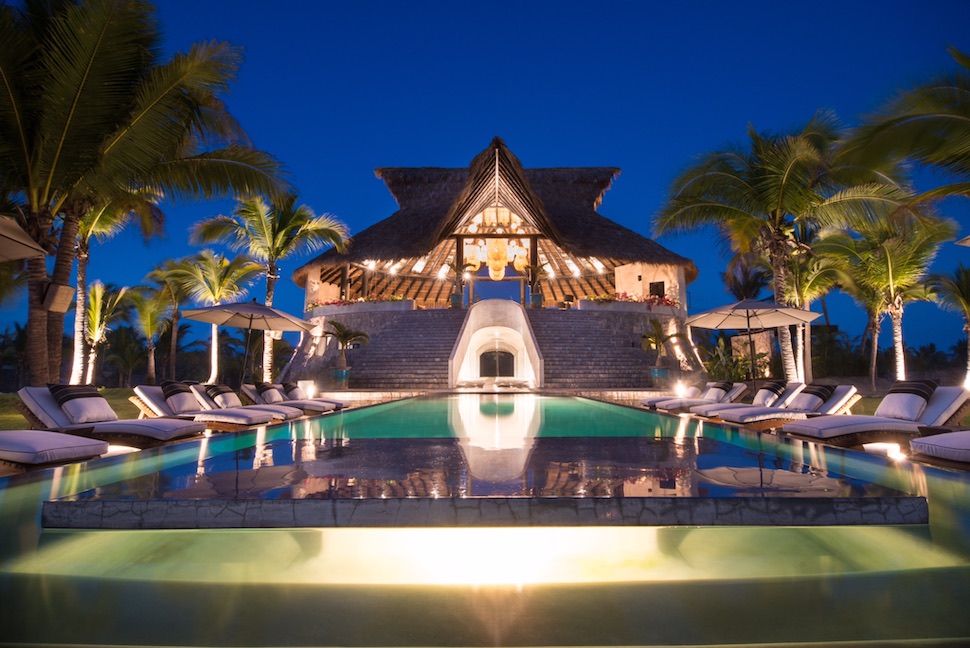
Personal transformation can come cheap: Forty nights in the desert with nothing but your demons will change your life. Guaranteed! But most of us seeking transformation want structure, specifically a pyramid. Think Maslow: We want a wide base of security that builds stepwise to a point of self-actualization—that aha! when we experience the self we want to be—or remember being—and then we want to come home with renewed hope and new tools to keep going. We want our “dark night of the soul” lit with fireworks: A retreat that’s deep, meaningful, healing, and spectacularly fun.
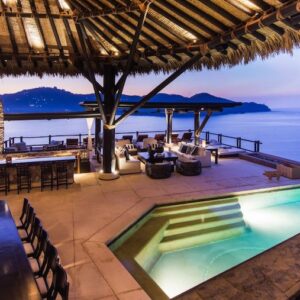 So, nowadays there is intense competition worldwide to build truly grand pyramids. But here’s the rub: No one who builds one can actually say when or even if any significant transformation is going to take place. You build your pyramid with your recipe of rituals and then you add people, set them climbing, and see what happens. And from long experience, I can say that some attempts at transformation turn out to be cringeworthy. In the thick of the “grand” experience, you wish you were home watching Netflix. And if the transformational pyramid is built in Mexico, it starts from a deficit: Mexican pyramids are steep and there’s a lurking fear—unfair, but still there—that the ritual could involve getting your heart cut out or your head cut off. Ouch!
So, nowadays there is intense competition worldwide to build truly grand pyramids. But here’s the rub: No one who builds one can actually say when or even if any significant transformation is going to take place. You build your pyramid with your recipe of rituals and then you add people, set them climbing, and see what happens. And from long experience, I can say that some attempts at transformation turn out to be cringeworthy. In the thick of the “grand” experience, you wish you were home watching Netflix. And if the transformational pyramid is built in Mexico, it starts from a deficit: Mexican pyramids are steep and there’s a lurking fear—unfair, but still there—that the ritual could involve getting your heart cut out or your head cut off. Ouch!
What’s the secret of what’s probably the best new retreat in Mexico? Potentially, one of the best retreats anywhere? The proprietor of the property and co-owner of ZihFit, J. Ben Bourgeois, is getting to the answer as we sip cool mocktails atop his spectacular beachfront pyramid/palapa set in what was once a coconut plantation in Zihuatanejo. Chilled coconuts abound and all are filled with yummy, low-calorie concoctions. I’ve just had my daily massage, and I’m about to get a surprise pedicure; but right now, Ben is telling me about his own journey to this point: “The best time of my life.”
Coming Out
Ben’s from Georgia. His dad’s family was “in flowers.” His mom’s family was “in boring banking.” He went to LA at age 22 planning to create parties and he had an introduction at Warner Brothers, where he realized that the backlot movie sets and the access to cheap special effects could create spectacular corporate events. That was some thirty years ago and nowadays Ben creates grand spectacles all over the world; in fact, he had just flown in from orchestrating the Concours d’Elegance with Jay Leno for 50,000 guests in Beverly Hills. During his ascent to the top of the event world, he came out as gay. It was a time when the great dams holding back torrents of pent-up creativity and sexuality suddenly burst, and he was atop the big wave and wanted a special place for his own wild events.
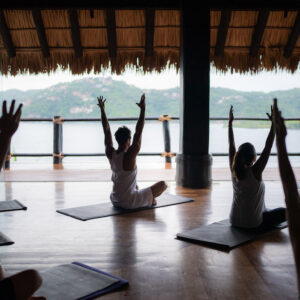 So, a couple decades ago, he built a magnificent cliffside palace in Zihuatanejo overlooking the ocean. Then he realized he needed bathrooms on the grand beach at this coconut plantation for when his partygoers took a boat ride to play in the waves. Ben bought the beachfront and built his quasi-Mayan pyramidal palapa with another grand swimming pool, guest rooms, and outdoor massage facilities.
So, a couple decades ago, he built a magnificent cliffside palace in Zihuatanejo overlooking the ocean. Then he realized he needed bathrooms on the grand beach at this coconut plantation for when his partygoers took a boat ride to play in the waves. Ben bought the beachfront and built his quasi-Mayan pyramidal palapa with another grand swimming pool, guest rooms, and outdoor massage facilities.
Then, just a few years ago, he had another grand awakening after meeting his personal trainer Eduardo Penteado, a Brazilian who studied international business, went to work for Microsoft in Miami, but really wanted to be a model in LA before he found his true calling (as an Olympic athlete, I can say that Eduardo is a remarkably good trainer). Using intense workouts, yoga, dance, calorie-restricted healthy food, and mocktails, Eduardo not only transformed Ben’s body by dropping 40 pounds, he transformed Ben’s life so dramatically that Ben became a convert to a different kind of extreme fun—based on super-clean living. Next, the uber-party-giver and the personal trainer decided to co-create ZihFit to spread the experience.
So what’s the real secret to ZihFit? Ben smiles, looking around proudly at his creation, “This place was built for debauchery!” And what that means is that the retreat is built on a base of absolute security and safety, and then the steep climb goes deep, is remarkably healing, and is extraordinarily fun. That’s Ben and Eduardo’s genius and ZihFit’s magic. If you have to ask, you probably can’t afford it. But here’s how it goes.
So what’s the real secret to ZihFit? “This place was built for debauchery!”
Arriving at ZihFit
Ben says that the best of his wild old parties typically began in someone else’s private jet. The ZihFit retreat, however, begins with the next best thing: A direct flight from Los Angeles, or Phoenix, or Dallas to Ixtapa/Zihuatanejo. ZIH is as bustling as Cancun was some forty years ago and yet has new technology to get you through customs about as fast as you can walk. The shuttle driver waiting curbside is from the staff of ZihFit’s parent group, Dos Fiestas—the name of the combined cliffside Casa Fiesta and the beachfront Casa Playa. On the fifteen-minute drive to the quietly charming still-Mexican beach town of Zihuatanejo, I learn that the driver has been working for “Mr. Ben” for many years, and it’s clearly a job that he is very happy to have. We drive through town and then, just beyond the port, we turn and go up a steep winding road to an unobtrusive but very solid gate that gives no sign that anything of interest is beyond. In fact, the gate conceals a private and dramatically rocky peninsula jutting into the Pacific.
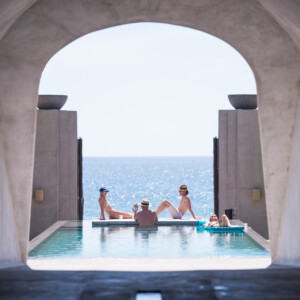 The gate opens automatically to a rustically manicured private road and soon there another wall and another gateway, but this one is manned with attendants holding cold drinks and cool wet towels. Through this second gate is a reflecting pool and stone stairs and paths down the cliff with glimpses of ocean vistas that grow more jaw-droppingly beautiful until you reach an elegant yet comfortably indestructible bacchanalia bar and deck area and a long communal dining table, swimming pool, and an enormous dinner gong that resonates with the sounds of seabirds and breakers crashing against rocks below.
The gate opens automatically to a rustically manicured private road and soon there another wall and another gateway, but this one is manned with attendants holding cold drinks and cool wet towels. Through this second gate is a reflecting pool and stone stairs and paths down the cliff with glimpses of ocean vistas that grow more jaw-droppingly beautiful until you reach an elegant yet comfortably indestructible bacchanalia bar and deck area and a long communal dining table, swimming pool, and an enormous dinner gong that resonates with the sounds of seabirds and breakers crashing against rocks below.
I walked down more steps and through the open door of my room with its 12-foot ceilings that opened to my private patio with a glorious cliff-top shower I couldn’t wait to try. Back in the room, I then noticed my clothes were already hanging in the closets and folded in the drawers. Also in the closet, I was struck by something: The room safe was locked—open. My door also had a lock but I didn’t have a key, and I would gradually learn that the safest place for my possessions was wherever I happened to leave them. A small example, I left a treasured shirt on an off-property excursion, and it made its way back without me mentioning the loss. Yet there was no sense of surveillance.
The sense of safety came from the graciousness of the attentive staff who clearly thought they had the best jobs in the best place around. Another small example: A space we would use for a cacao ceremony was also a disco and is equipped with a large costume room like a movie set where, in former days, the staff chose wigs to deliver to the rooms before dinner. What fun! My guess is that the staff has seen everything, and it is all good.
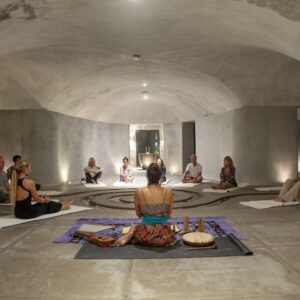 Our retreat group of eight first gathered for a half hour drive back through town to what proved to be dinner on the beach just outside the two-foot-thick walls of Casa Playa. Not your usual beach barbecue, this was an elegant sit-down with fine china and a blazing fire between us, the breaking waves, and the setting sun. Afterwards we gathered on yoga mats in candlelight in the tunnel through the base of the pyramid for an opening ceremony that involved singing bowls and individually singing our names to the group. In other hands, this could have been cringeworthy or worse, but Ben has spent thirty years finding top talent for spectacular events. He’s an artist at assembling teams. Likewise, Ben and Eduardo proved to be artists at assembling rituals.
Our retreat group of eight first gathered for a half hour drive back through town to what proved to be dinner on the beach just outside the two-foot-thick walls of Casa Playa. Not your usual beach barbecue, this was an elegant sit-down with fine china and a blazing fire between us, the breaking waves, and the setting sun. Afterwards we gathered on yoga mats in candlelight in the tunnel through the base of the pyramid for an opening ceremony that involved singing bowls and individually singing our names to the group. In other hands, this could have been cringeworthy or worse, but Ben has spent thirty years finding top talent for spectacular events. He’s an artist at assembling teams. Likewise, Ben and Eduardo proved to be artists at assembling rituals.
Daily Journeys
The days that followed involved rising at dawn, hitting the outdoor shower, and climbing the stairs for coffee on deck and an hour of yoga overlooking the ocean. Then came a light fruit-filled breakfast at a round table, and a drive to the beach. We didn’t stop at Casa Plaza; instead, we were driven about three and a half miles further, and then we walked and talked back along the beach. Remarkably, we hardly saw another person—other than staff behind carrying cold water and towels and occasionally our driver in case the 90-minute walk felt too far. Upon reaching Casa Playa, there were snacks like chia seed pudding and cold drinks and time for dips in the pool before an hour-long dance workout on the lawn. Then lunch atop the pyramid, an open-air massage with a different practitioner each day, some kind of ritual, and finally dinner set at a new grand ocean vista at Casa Fiesta.
There was no alcohol, just mocktails, and not a lot of food—1,300 calories spread throughout the day in fine meals and snacks. And there were hours of yoga, walking and dancing each day. In short, ZihFit is serious fitness, but it’s nothing like an athletic training camp. As our yoga instructor exhorted us each morning in what became a meme, ZihFit was a chance to “explore the possibilities!” You do what you like, so I did it all—overdid it—and ended up being worked on by Eduardo, which is why I know he’s as good as he looks. You don’t have to do it all, and probably shouldn’t if you’re 65, but the stretching of yoga and being stretched in massage, combined with the movement of beach walking and dancing and playing in the pool, was all about lightening-up both literally and metaphorically—and also about getting really tired and crashing to the sound of surf. Nice.
Rituals Abound
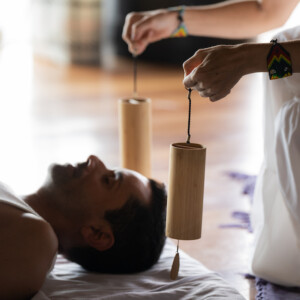 The silliest ritual was a floating sound bath: eight of us on lying on foam floats and wearing blackout shades in the long and narrow Playa pool accompanied by our sound healer. It proved to be a combination of isolation tank and gentle bumper cars as we bobbed and bounced off one another in the breeze. Healing? Who knows. I needed the nap.
The silliest ritual was a floating sound bath: eight of us on lying on foam floats and wearing blackout shades in the long and narrow Playa pool accompanied by our sound healer. It proved to be a combination of isolation tank and gentle bumper cars as we bobbed and bounced off one another in the breeze. Healing? Who knows. I needed the nap.
The most powerful ceremony was off-site in a Temazcal, a traditional Mexican sweat lodge, led by a traditional Mexican grandmother/shaman named Lupita and her apprentice/translator, Sara Nacach, who had led our opening ceremony. The ritual began with a blessing outside the fire-heated dome, crawling into the dark space, and being taken on a journey of intense heat in total blackness to the songs and questions of a shaman. I live on Native American ceremonial land and have been the caretaker of many sweat lodges, so I know the first time can be claustrophobic to the point of terrifying—or so hot you have to hug the ground or flee. But if you can let go into the practice and even stand up for a time, you become a flowing river of sweat that is not only cleansing but pointing somewhere—whether or not you believe the dome is also filled with spirit guides. I lost my shirt in this sweat, and it came back cleaned. That, among other things in the Temazcal, helped restore my peculiar kind of faith.
The closing ritual came after breakfast before we were driven back to the airport. It was a cacao ceremony, a heart-filled guided meditation that makes the world’s most traditional hot chocolate not just more delicious but sacred—and is a quietly powerful reminder that all this super-clean retreat living is quite simple if you set your mind to it.
Stephen Kiesling
Stephen Kiesling is a writer and editor whose career was launched in 1982 with the classic rowing book The Shell Game and The New York Times Book Review, “Just as it is good that there was a riverboat pilot who could write…it is good that there is one true blue jock who can.” A Scholar of the House in philosophy at Yale, Stephen was a 1980 Olympic oarsman who also raced in the 2008 Olympic Trials. He learned journalism from T George Harris, a decorated World War II artillery scout and Time reporter who created Psychology Today. T George and Stephen launched both American Health magazine and Spirituality & Health, where Stephen continues as Editor at Large. He has written for the New Yorker, Sports Illustrated and Outside, was a spokesman for Nike, started a celebrated rowing club, and has built parks and playgrounds. He lives at Ti’lomikh Falls on the Rogue River in southern Oregon, where he writes for his wife Mary Bemis at Insidersguidetospas.com. Stephen is also the caretaker of one of America’s oldest Salmon Ceremonies and is working on a whitewater park and sculpture garden. He is interested in transformational retreats, anything to do with water, the Native American origins of our democracy, and the process of becoming what he calls an Earth-Indigenous Elder, a person who knows their own story from the beginning of time.